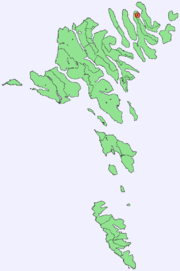
Múli
Encyclopedia

Borðoy
Borðoy is an island in the north-east of the Faroe Islands. There are eight settlements: Klaksvík , Norðoyri, Ánir, Árnafjørður, Strond, Norðtoftir, Depil and Norðdepil. There are also three abandoned settlements: Skálatoftir, Múli and Fossá, all in the north...
in the Norðoyar
Norðoyar
The six islands in the northeast of the Faroe Islands are together referred to as Norðoyar, i.e. the Northern Isles . These Islands are Kalsoy, Kunoy, Borðoy, Viðoy, Svínoy and Fugloy. Klaksvík is regarded as the natural capital of this region. Norðoyar is sometimes spelled Norðoyggjar.-Further...
Region of the Faroes.
- Population: 4 (February 2005)
- Postal Code: FO-737
- MunicipalityMunicipalities of the Faroe IslandsThe Faroe Islands are administratively divided in 30 municipalities , with about 120 cities and villages. Until December 31, 2008, there were 34 municipalities, and until December 31, 2004, there were 48 municipalities...
: Hvannasunds kommuna
Múli lies on the outermost northern edge of Borðoy's east coast. Its settlement can be dated back to the 13th century. Múli became the last community in the archipelago
Archipelago
An archipelago , sometimes called an island group, is a chain or cluster of islands. The word archipelago is derived from the Greek ἄρχι- – arkhi- and πέλαγος – pélagos through the Italian arcipelago...
to receive electricity in 1970. It was lated connected with Norðdepil
Norðdepil
Norðdepil is a town on the island of Borðoy in the Norðoyar Region of the Faroes.*Population: 169 *Postal Code: FO-730*Municipality: Hvannasunds kommuna...
by Road 743 in an attempt to stop depopulation. Nevertheless, Múli has been considered abandoned since 2002, though there are still four registered residents. During the Summer months some of its former residents use their old houses as vacation homes.
The Open Air Museum of the National Museum of Denmark
National Museum of Denmark
The National Museum of Denmark in Copenhagen is Denmark’s largest museum of cultural history, comprising the histories of Danish and foreign cultures, alike. The museum's main domicile is located a short distance from Strøget at the center of Copenhagen. It contains exhibits from around the world,...
, north of Copenhagen
Copenhagen
Copenhagen is the capital and largest city of Denmark, with an urban population of 1,199,224 and a metropolitan population of 1,930,260 . With the completion of the transnational Øresund Bridge in 2000, Copenhagen has become the centre of the increasingly integrating Øresund Region...
, holds two old houses from Múli, which were taken apart in the Faroes and then rebuilt on site at the museum.
See also
Danish site with photographs of Múla

